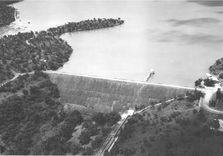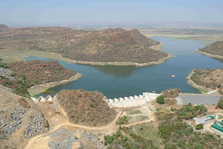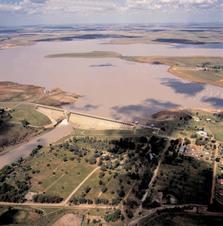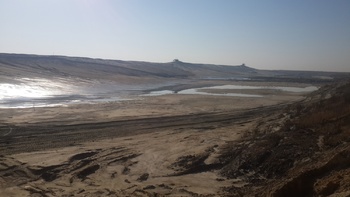Technical One-Day Tours
Technical One-Day Tours have been arranged for both Sunday 15 May and Thursday 19 May to make provision for those delegates wishing to attend the Workshops on 19 May. The tour programme is given in the tables below. The tour cost is included in the registration fee. Meet in the foyer of the Sandton Convention Centre at least 15 minutes before the departure time. Tours will depart promptly at the stated times. Please wear long pants and sturdy, closed shoes.
| Technical Tours on Sunday 15 May | Technical Tours on Thursday 19 May | |||||
| Time | Tour | Time | Tour | |||
| 07:30 - 17:00 | TT 1 Rust de Winter Dam | 07:30 - 17:00 | TT 6 Rust de Winter Dam | |||
| 07:30 - 16:00 | TT 2 Bospoort Dam | 07:30 - 16:00 | TT 7 Bospoort Dam | |||
| 07:30 - 18:00 | TT 3 Vaal Dam & VRESAP System | 07:30 - 18:00 | TT 8 Vaal Dam & VRESAP System | |||
| 08:00 - 17:00 | TT 4 Acid Mine Drainage Project | 08:00 - 17:00 | TT 9 Acid Mine Drainage Project | |||
| 08:00 - 16:00 | TT 5 Tailings Retreatment Project | 08:00 - 16:00 | TT 10 Tailings Retreatment Project | |||
Rust de Winter Dam (TT 1 and TT 6)
Rust de Winter Dam is a 31 m high CFRD dam situated on the Elands River approximately 60 km north of Pretoria. The dam was built in 1934 for irrigation purposes and is registered as a category III dam with the Dam Safety Office of the Department of Water and Sanitation (DWS). The dam underwent rehabilitation in 2012 due to the following problems:
- Inadequate spillway capacity - The spillway had a discharge capacity of 1 835 m3/s and a Safety Evaluation Flood (SEF) of 3 385 m3/s.
- Intake and outlet works mechanical/electrical equipment were in dire need of maintenance.
- Operation and Maintenance Manual and Emergency Preparedness Plan were not adequate.
- Auxiliary embankment was in bad shape

 |
|
Why Willowstick?Is your dam leaking? Through revolutionary technology we can show you the leak path in plan and elevation. Willowstick Technologies and Atkins Global are specialists in mapping leaks through, under or around dams. The Willowstick method quickly identifies preferential seepage pathways. No more guessing. We can show you the entire seepage pathway in plan and elevation. The method is non-intrusive and quick- we can show you initial results the day after measurements are collected. You may know where seepage is exiting your dam. If you are lucky you might know where it is entering the embankment. With Willowstick you can now know precisely how the leakage is making its way through or under the dam. For the first time you are able to target your remedial works because you know the depth and location of the leak. For more information please visit www.Willowstick.com or contact Dr Andy Hughes Andy.Hughes@atkinsglobal.com .Alternatively, why not come and see for yourself. We will be carrying out a demonstration at Rust De Winter dam on the 15th and 19th May as part of the technical tour. |
|
Bospoort Dam (TT 2 and TT 7)
Bospoort Dam is a 28 m high concrete gravity structure dam situated on the Hex River near the town of Rustenburg in the North-West Province. The dam was completed in 1933 and has since been raised three times. The first raising was for 5 m in 1953 and that included changing the original buttress structure into a concrete gravity section. In 1972 the dam was further raised and 3,2 m high radial gates were installed as well as 75 tensioned cables (800 kN) to enhance the stability of the gravity wall. The dam is used to supply potable water to the town of Rustenburg. Recent rehabilitation work included the removal of the 12 radial gates and replacing them with a labyrinth spillway. The motor coach will depart from Sandton and the trip is a 2,5 hour drive to the dam. Lunch will be served on site. On the way back from Bospoort Dam, the return trip will go via the Hartbeespoort Dam which is a 59 m high variable radius arch dam constructed in 1923.

Vaal Dam and the VRESAP System (TT 3 and TT 8)
The motor coach will leave Sandton and travel for approximately 2 hours where the delegates will be given a guided tour of Vaal Dam which is the main component of the Vaal River System which supplies water to the metropolitan area of Gauteng. A briefing of how the VRESAP system (a large water transfer project) operates. There will be an opportunity to visit one of the VRESAP sites.


Acid Mine Drainage Project (TT 4 and TT 9)
Mine water started accumulating in old mine workings as underground operations ceased and withdrew from the mining basins, leaving deep shafts that provide direct access for water and oxygen to underground rock surfaces. The water that filters into these empty shafts via recharge and runoff water is characterised by acidity, high metal content and high salinity, and is known as Acid Mine Drainage (AMD). An emergency short-term intervention to neutralise the AMD and discharge it into the river system was required whilst the feasibility study for a long-term solution was being undertaken. The short-term intervention is underway in all three basins and consists of:Installation of pumps to extract water from the mine void to on-site treatment plants;
- Construction of an on-site water treatment plant in each basin with the option of refurbishing and upgrading the existing plants owned by the mines. The Central Basin High Density Sludge (HDS) Plant will treat 72Ml/day. The Eastern Basin HDS Plant will treat 106 Ml/day;
- Installation of infrastructure to convey treated (neutralised) water to nearby water courses.
Tailings Retreatment Project (TT 5 and TT 10)
Pan African Resources (PLC), owners of Evander Gold Mines (Pty) Limited, is currently re-treating gold tailings deposited on the Kinross Tailings Storage Facility (TSF). The tailings are being hydro-mined by Fraser Alexander (Pty) Ltd, which involves re-pulping the tailings utilising high pressure water and pumping the resultant tailings slurry to the Kinross Gold Plant for processing and further gold extraction. The re-processed tailings are then pumped to and deposited by Fraser Alexander on the nearby Winkelhaak TSF.



